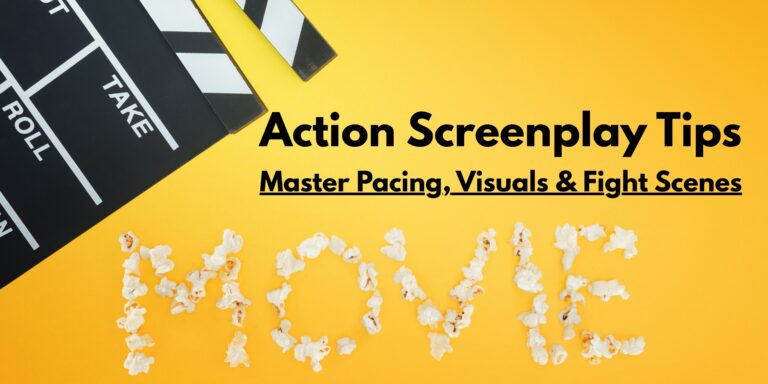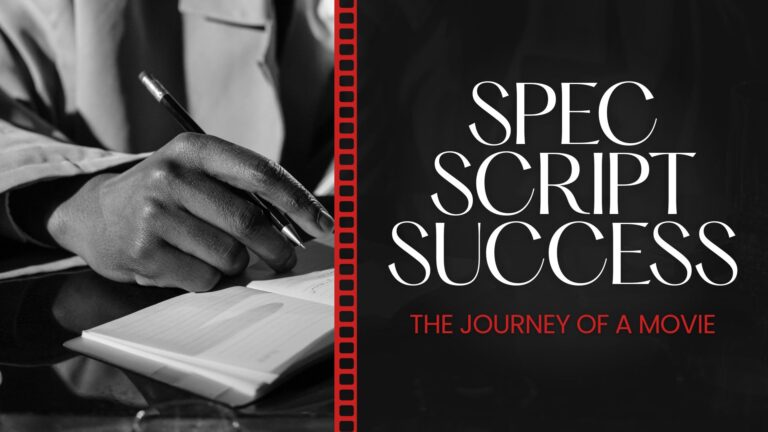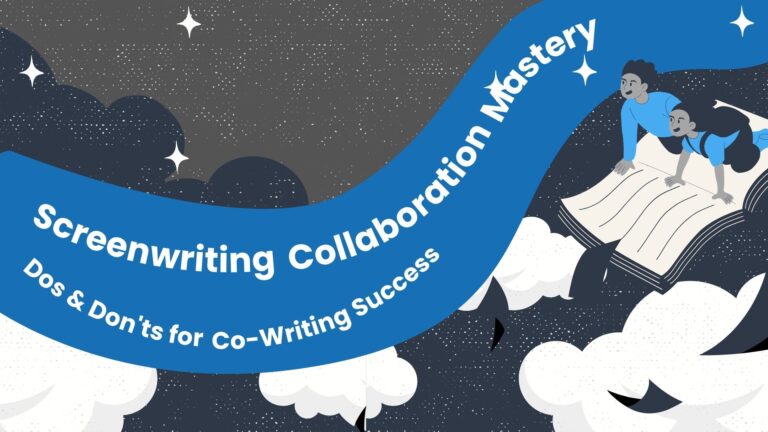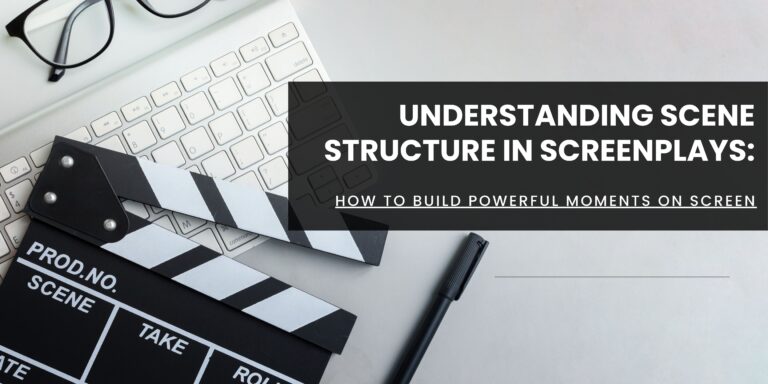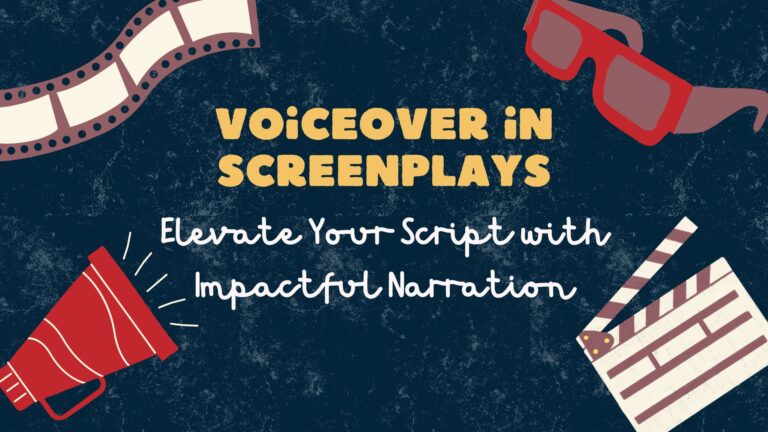Mastering Conflict in Screenwriting: Unleash Magnetic Screenplay Tension
Ever wondered why some screenplays make your heart race while others barely get a glance? It all comes down to one secret ingredient: conflict in screenwriting. Think of it as the lightning that sparks a storm; without it, your story drifts aimlessly like a sailboat without wind.
Conflict doesn’t just push your plot forward; it gnaws at your characters’ insides, challenges their choices, and keeps your audience leaning in, eager to see what happens next. From the simmering tension in a rom-com to the high-stakes drama of a thriller, every unforgettable scene thrives on conflict.
It’s the invisible engine that transforms ordinary dialogue into electric exchanges, ordinary choices into life-altering decisions.
In this guide, we’ll explore how mastering conflict in screenwriting can make your characters more compelling, your plot more gripping, and your audience utterly hooked.
So, grab a cup of coffee, lean in, and tag along as we dive into the world of conflict in screenwriting.
What Is Conflict in Screenwriting?
Imagine trying to light a fire without a spark; it doesn’t matter how much wood you pile up, nothing ignites. That’s precisely what happens when a screenplay lacks conflict.
Conflict in screenwriting is the unseen current that keeps a story alive. It’s not just a dramatic tool; it’s the very engine that drives every scene forward, shaping characters and keeping audiences on the edge of their seats.
Read more: Electrifying Screenplay Plot Twist Techniques: Surprise Without Losing Your Audience
Without conflict, stories collapse like a house of cards in the wind. Characters stand still, the plot drifts into silence, and the audience checks out.
But when you weave in rich, meaningful conflict, you breathe life into your script. Suddenly, stakes rise, choices matter, and emotions grip your audience like a vice.
The Vital Role of Conflict in Screenwriting
Conflict isn’t just a hurdle; it’s the lifeblood of storytelling. To master your craft, you need to understand how this force fuels your plot, molds your characters, and hooks your audience.
From propelling events forward to revealing the deepest layers of a character, conflict is the engine behind every compelling story.
Let’s break down its key roles:
Fuels the Plot
View conflict as the gasoline in your screenplay’s engine. Every clash, obstacle, or ticking clock propels your story forward. Without it, your narrative stalls out like a car on an empty tank.
Just as Rocky’s battles in the eponymous film kept his journey alive, your characters need obstacles that push them into motion and prevent stagnation.
Shapes Your Characters
Characters are like clay; they don’t take shape without pressure. Conflict in screenwriting applies that pressure, revealing fears, flaws, and hidden strengths. It’s through challenges that your characters transform.
Consider how challenges push Rocky past self-doubt; conflict doesn’t just test them; it sculpts them into someone audiences can root for.
Hooks Your Audience
Conflict is the magnetic pull that keeps viewers invested. It stirs suspense, builds anticipation, and fuels empathy.
The audience doesn’t just want to watch what happens; they need to feel what’s at stake. A well-crafted conflict lures them in, keeping them emotionally invested in your story until the final frame.
In essence, conflict in screenwriting isn’t optional; it’s non-negotiable. It’s the keystone that carries your script from its first spark to its final curtain call.

Internal vs. External Conflict: Unlocking Emotional Depth
Conflict in screenwriting is the driving force behind any story, and understanding the difference between internal and external conflict is crucial to crafting compelling narratives.
Internal conflict drives characters from the inside, forcing them to wrestle with emotions, fears, or desires. External conflict, on the other hand, pits characters against obstacles in the world around them, such as situations, different characters, or forces of nature.
Mastering both and letting them feed off one another elevates storytelling, making scripts resonate long after the film ends.
Understanding Internal Conflict: The Battle Within
Internal conflict is the struggle that occurs inside a character’s mind and heart. It’s what keeps them awake at night, what makes choices agonizing, and what shapes their emotional arcs.
Classic examples include depression, fear of commitment, addiction, or evolving personalities, like James McAvoy’s character in Split, who literally embodies multiple conflicting selves.
Read more: Powerful Screenplay Opening Scenes: Master the First 10 Pages with Irresistible Hooks
Even in epic adventures, internal conflict shines: Frodo’s fight against the Ring’s power in The Lord of the Rings or Indiana Jones reconciling his feelings toward his father illustrate how internal struggles can define a character’s journey.
Writing internal conflict may seem challenging, but it’s the secret ingredient that makes stories leap off the page and stay alive in audiences’ minds.
External Conflict Unpacked: When the World Pushes Back
External conflict is easier to spot; it’s the physical or situational struggles your characters face. Think of characters trapped in a trash compactor as they survive a galactic showdown against Sith Lords; these outside pressures test the characters and push the plot forward.
The fundamental difference? Internal conflict lives inside a character; external conflict exists in the world around them. For a layered story, you need both, ideally feeding off one another.
Raiders of the Lost Ark, for instance, presents external challenges, such as Nazis chasing Indiana Jones, which ignite internal battles over trust, morality, and perseverance.
External conflict comes in all shapes and sizes: the oppressive control of machines in The Matrix, the chaotic misadventures of Jinx the cat in Meet the Parents, or the sinking Titanic forcing Rose to confront love and courage.
The stakes, not the size of the conflict, determine its power. The key is pairing the right internal struggle with the right external obstacle, creating tension that resonates.
If Rose in Titanic didn’t question her feelings for Jack, the sinking ship loses emotional punch. If Neo in The Matrix doesn’t question his role as “The One,” the external threats of the Agents fall flat.
Combining these elements transforms ordinary plots into gripping stories with high emotional stakes.
Read more: Script vs Screenplay: What’s the Real Difference
Together, internal and external conflicts act like twin engines driving your story forward. You’ll see this dynamic not just in epic dramas, but also in rom-coms (Jim and Pam in The Office) and even animation (Buzz Lightyear in Toy Story).
Across genres, the richest stories are those where the outside world challenges the character as much as their inner world does.
The Must-Know Types of Conflict in Screenwriting That Power Great Stories
Across literature, film, and television, there are six primary types of conflict that every screenwriter should master. While these fall under internal or external categories, understanding them individually and in combination creates richer, more compelling stories.
Man vs. Self: The Inner Battlefield
This is the classic internal conflict. Characters universally wrestle with doubts, fears, or moral dilemmas: Don Draper in Mad Men battles self-destruction, and Midge Maisel in The Marvelous Mrs. Maisel navigates independence.
- Examples: Multiplicity brings internal struggle to life; Orphan Black explores identity through the conflicting personalities of its characters.
- Tip: Sometimes internal struggles manifest externally, blurring the lines between inner and outer conflict.
Man vs. Man: The Clash of Characters
The most common external conflict. Protagonists face antagonists or rivals, creating palpable tension. Think Star Wars, comic book epics, or sitcoms like The Good Place.
- Twist: Man vs. Man can internalize into Man vs. Self, as seen in instances where possession or psychological control forces a character to battle themselves (e.g., Harry Potter and the Order of the Phoenix, Get Out).
Man vs. Society: One Against the Many
External forces pressure the protagonist against societal norms or group expectations. Examples include political thrillers or tragic tales, such as The Elephant Man.
- Film: Boys Don’t Cry explores society’s rejection of Brandon Teena’s identity.
- TV: Succession portrays family power struggles across multiple seasons, with its internal dynamics evolving over time.
Man vs. Nature: Battling the Elements
When the environment turns hostile, characters are tested physically and emotionally. The Revenant and Homeward Bound showcase classic Man vs. Nature.
- TV Example: Sitcoms often feature “nature episodes” (New Girl vs. a coyote encounter).
- Inner Twist: Natural challenges can spark internal conflict, forcing characters to adapt or confront their limitations.
Man vs. Machine: Humanity on the Line
From John Henry hammering spikes to iRobot, this conflict pits humans against technology.
Layered storytelling emerges when characters face internal struggles alongside external threats.
Terminator 2 shows machines evolving, while Artificial Intelligence explores a robot’s desire to become human.
Man vs. Fate & the Supernatural: Wrestling with the Unseen
These conflicts revolve around intangible concepts, such as destiny, gods, or supernatural forces.
- Biblical Example: Job battles external divine tests while wrestling with internal despair.
- Film & TV: The Leftovers, Mission Impossible, and A Serious Man depict characters facing forces beyond their control, blending internal and external stakes.
Mastering these conflicts is essential for any writer who wants to craft stories that linger long after the narrative concludes. Conflict in screenwriting isn’t just a device; it’s the engine of cinematic life.
Turning Up the Drama: Using Conflict in Screenwriting Like a Pro
When you sit down to write a screenplay, it’s easy to get lost in dialogue and plot points, but the real magic happens when you integrate conflict in screenwriting like a master mechanic fine-tuning an engine.
Picture your story as a car: if only one side of the wheels is moving, your tale spins in circles. But when both sides turn in harmony, internal and external conflict together, your story accelerates, driving straight toward unforgettable drama, no matter the genre.
Conflict in Every Scene
Ask yourself this simple question for every scene: How does this scene interact with the conflicts I’ve built? The answers will turn ordinary moments into cinematic gold.
- Example – Western Drama: In The Good, The Bad, and The Ugly, the climactic gunfight isn’t just about bullets flying. As the camera spins, the characters’ internal struggles spin too. Trust, greed, honor, these inner battles amplify the external danger, creating a tense, layered finale.
- Example – Comedy: Consider the infamous “Frank and Beans” scene in There’s Something About Mary. The external conflict, a bizarre and awkward mishap involving Ben Stiller, intersects with his inner conflict: desire, love, and the fear of ruining the perfect romantic moment. The scene is hilarious because the emotional stakes mirror the physical chaos.
- Example – Action: Die Hard demonstrates that action-packed standoffs are most effective when combined with emotional stakes. John McClane isn’t just fighting terrorists; he’s grappling with his relationship with Holly. The external threat (Hans Gruber and the building) and internal journey (rebuilding his marriage) intertwine, giving every explosion and every bullet a deeper resonance.
Why This Matters to You
Understanding how to use conflict in screenwriting isn’t just a writing exercise; it transforms your stories from flat scripts into gripping narratives. When internal and external conflicts interplay:
- Audiences stay emotionally invested.
- Scenes carry tension, even in dialogue-heavy moments.
- Characters feel real, with choices that matter.
- Your screenplay gains depth across various genres, including comedy, action, drama, and romance.
The key is to introduce conflicts thoughtfully. Let internal struggles influence external action, and let external pressures reveal inner truths. This “conflict dance” creates a story that reverberates well past the ending.
Building Character Conflict Audiences Truly Relate To
Great stories aren’t just about what happens, they’re about who it happens to. Conflict in screenwriting becomes unforgettable when it reflects authentic human behavior, giving audiences someone to cheer for, or even love to hate.
Relatable conflict pulls viewers in, making them care about every choice, every stumble, and every victory. To turn these relatable struggles into unforgettable drama, it’s essential to shape characters whose personalities, goals, and histories naturally ignite conflict.
Building Multi-Dimensional Characters That Spark Conflict
Characters should feel like real people, with beliefs, goals, and quirks that naturally collide. These differences ignite tension, driving the story forward.
- Inside Out demonstrates this beautifully: Joy and Sadness’s contrasting perspectives fuel both conflict and resolution, showing how character differences can anchor emotional stakes.
- Understanding the types of conflict (internal vs. external, Man vs. Man, and Man vs. Self) provides deeper insights into how these clashes can be addressed naturally.
Weaving Backstory and Motivation into Character Conflict
Conflict gains depth when it’s rooted in backstory. A character’s past experiences, traumas, or beliefs explain why certain obstacles feel personal and why their reactions resonate.
- Good Will Hunting illustrates this perfectly: Will’s childhood trauma shapes his emotional barriers, giving his internal struggles weight and realism.
- Tip: Ask yourself, what drives your character? What past pain or unresolved desire fuels their reactions? This is where authentic conflict lives.
How Personality Clashes Fuel Conflict in Screenwriting
Sometimes, the richest conflicts arise from simple differences in personality. Clashing temperaments, opposing values, or incompatible worldviews generate friction, making for dramatic scenes.
- Silver Linings Playbook leverages these clashes to create both tension and romance, proving that internal dynamics can be as engaging as any external threat.
- Rule of thumb: The more relatable the clash, the more invested your audience becomes.
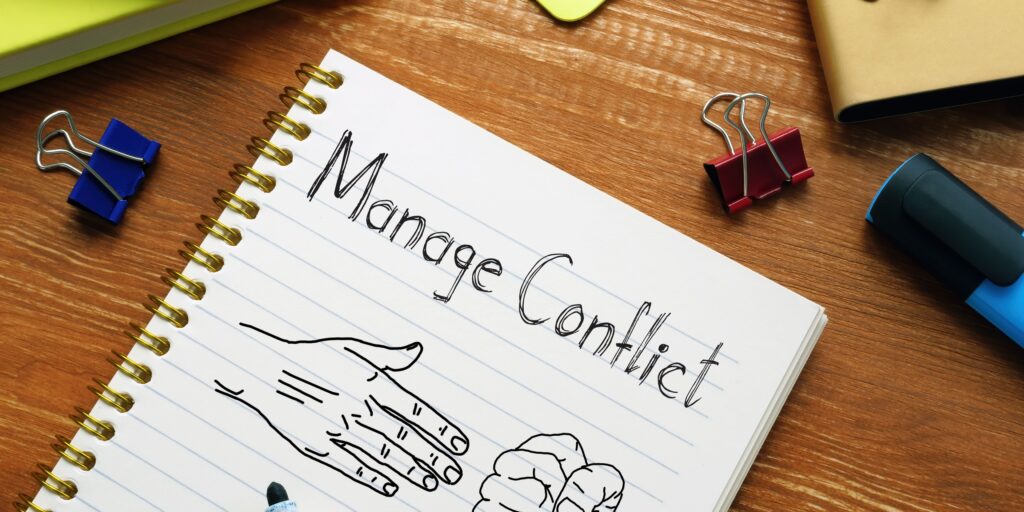
Building Story Tension: Layering Conflict Across Scenes
Conflict isn’t just a single obstacle; it’s a rhythm that drives story momentum. Like a drumbeat, it keeps audiences leaning forward, anticipating the next beat.
To understand how this rhythm of conflict truly drives a story, let’s examine how it influences every aspect of screenwriting, from character development to plot momentum, and from tension to resolution.
Conflict: The Engine Behind Compelling Stories
Drama thrives on change. Characters must evolve, relationships shift, and the world of the story transforms. Without obstacles, narratives stagnate.
Conflict in screenwriting forces characters to act, make choices, and confront flaws. It’s the friction that creates growth: a protagonist struggling against both internal and external challenges becomes compelling because they must adapt, rethink, or fight to survive.
Hooking Audiences with Tension
Have you ever noticed how certain movies or shows make you lean forward in your seat? That’s tension at work, a product of expertly woven conflict.
- High stakes make every moment count.
- The audience invests emotionally because each scene matters: Will the hero succeed? Will love triumph? Will justice be served?
Consider conflict as a storyteller’s secret weapon: it pulls viewers into your world and refuses to let them go until the climax delivers its answer.
Conflict as the Engine of Character Growth
Conflict is where characters reveal who they truly are. How they respond, fight, flee, or compromise, shows their values, flaws, and desires.
- Overcoming conflict transforms characters, deepening audience investment.
- Well-crafted conflict ensures that character arcs are satisfying and meaningful.
Driving Your Plot Through Conflict
Without conflict, plot progression stalls. Conflict provides the challenges that propel the narrative toward resolution, whether:
- A triumphant ending,
- A tragic conclusion, or
- An ambiguous, thought-provoking finale.
Weaving conflict across scenes and beats ensures that your story never loses momentum and that every twist resonates emotionally.
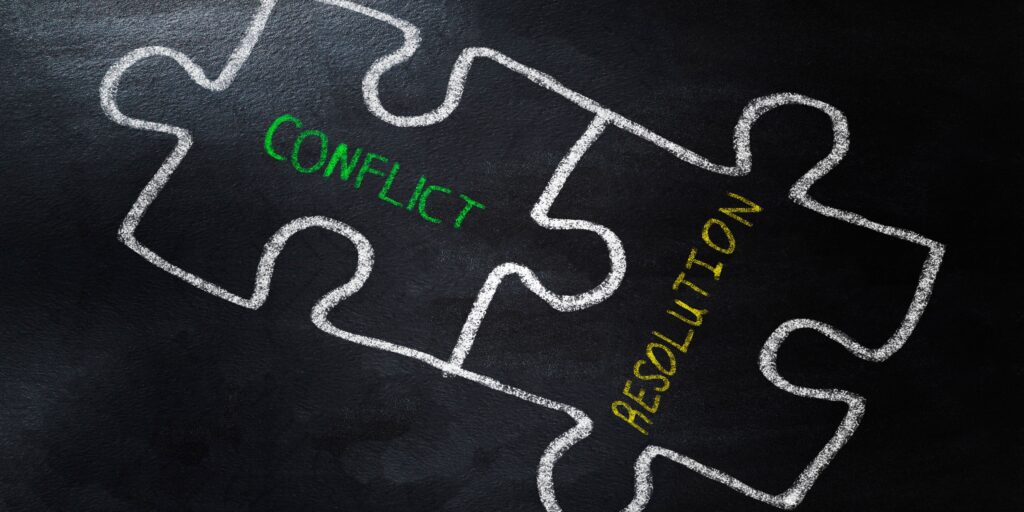
Turning Conflict in Screenwriting into Riveting Tension and Satisfying Resolutions
Mastering conflict in screenwriting isn’t just about creating obstacles; it’s about turning those obstacles into a pulse-pounding rhythm that keeps audiences holding their breath. The secret lies in building tension thoughtfully and delivering resolutions that feel both earned and emotionally satisfying.
To see how conflict transforms from a simple obstacle into gripping drama, let’s break down the tools and techniques:
Building Tension
Tension is the core of any screenplay. It grows from conflict but is fueled by how you escalate that conflict scene by scene. To translate this core tension into compelling scenes, focus on these key techniques:
- Raise the stakes: Make failure costly. The higher the stakes, the tighter the knot of suspense.
- Introduce twists and obstacles: Sprinkle complications along the narrative to make the eventual resolution feel hard-won. Knowing your resolution ahead of time helps you weave these plot turns seamlessly.
- Time constraints: Deadlines or ticking clocks push characters to act, increasing urgency and heightening dramatic tension.
- Moral dilemmas: When a character must choose between two undesirable options, the conflict gains depth, engaging the audience on a personal and emotional level.
Think of tension like winding a spring: the tighter you coil it with stakes, dilemmas, and obstacles, the more satisfying the release.
Slow-Burn vs. Fast-Paced Resolutions
Not every story resolves at the same tempo. Your choice between a slow-burning and fast-paced resolution can dramatically affect audience engagement. How you choose to settle your story, gradually or rapidly, shapes the audience’s emotional journey and the impact of your conflict.
- Slow-burn resolutions: Gradual tension is most effective in psychological dramas and character-driven narratives. Breaking Bad exemplifies this, as Walter White’s internal and external conflicts unfold over the course of multiple seasons. By the time climactic moments arrive, the tension feels explosive and well-earned.
- Fast-paced resolutions: High-intensity conflicts benefit from rapid, dramatic conclusions. Action films and thrillers rely on quick resolution to maintain momentum, keeping the audience’s adrenaline high until the last frame.
Both approaches rely on pacing your conflict in screenwriting so that stakes escalate naturally and emotionally.
Mastering the Balance Between Conflict and Resolution
Balancing conflict with resolution is a tightrope walk. Resolve too early, and the tension collapses; drag it too long, and the audience grows frustrated.
Pro tips for balance:
- Establish stakes early: From the opening scenes, clarify what’s at risk. The audience should understand why failure matters.
- Make resolutions feel inevitable: The climax should arise organically from the conflict, even if the ending is fast-paced and action-packed. Characters’ journeys should align with outcomes for maximum impact.
- Layer internal and external conflicts: Subplots involving secondary conflicts add depth without overshadowing the main storyline.
- Build to a peak, then release: Once tension reaches its peak, allow a brief moment of emotional or narrative relief, such as a character’s realization, a vulnerable moment, or an unexpected twist. Envision it as that brief pause at the top of a playground slide before the exhilarating descent.
Mastering Beats for Perfect Pacing
In conflict in screenwriting, beats are the secret gears that keep your story’s engine running smoothly. Consider beats as the backbone of your screenplay; each one is carefully timed to create rhythm, tension, and forward momentum.
Misaligned beats can make your story feel sluggish or jarring, while well-paced beats propel audiences effortlessly through the narrative.
Understanding Beats
A beat is a specific, measured action or moment that advances the story. Between beats, sequences unfold, a series of scenes that connect the previous beat to the next. The balance and spacing of these beats dictate the story’s pace:
- Uneven beats can bore audiences, creating gaps where nothing feels significant.
- Erratic beats can throw off viewers, breaking their immersion.
Different genres have different beat frequencies:
- Action films often feature numerous beats, emphasizing key events and physical challenges that drive the narrative forward.
- Dramas rely on fewer beats, focusing on character decisions and moments of discovery.
Beat Example: The Shawshank Redemption
To see beats in action, let’s break down a sequence from The Shawshank Redemption:
- 25 minutes: Andy approaches Red to request a rock hammer– Decision
- 30 minutes: Andy receives the rock hammer – Event
- 35 minutes: Andy risks his life offering financial advice to Mr Hadley – Decision
- 40 minutes: Andy begins testing the rock hammer on his cell wall, realizing it’s soft enough to chip away.– Discovery
After each beat, a sequence unfolds. These sequences are what connect the beats, but it’s the beats themselves, the pivotal decisions, discoveries, and events that audiences remember.
Each beat marks a moment where the protagonist’s life changes, pushing the story forward.
How Beats Shape Conflict
Legendary screenwriting teacher Robert McKee offers a refined perspective on beats. He defines a beat not just as a pause, but as: “An exchange of behavior in action/reaction. Beat by beat, these changing behaviors shape the turning of a scene.”
In practice:
- A scene contains multiple beats.
- Each beat represents a point of conflict or tension within the story.
- Collectively, beats guide the scene toward a story event, a significant turning point that alters the value-laden state of a character’s life.
By carefully structuring beats, writers ensure that conflict in screenwriting unfolds organically. Each beat intensifies tension, develops character, and nudges the plot toward a satisfying resolution.
Writing Conflict in Screenwriting That Resonates: Techniques to Amplify Storytelling Impact
Crafting conflict in screenwriting that genuinely connects with audiences is like conducting an orchestra. Every tension-building technique, from foreshadowing to pacing, plays in harmony to create a story that grips readers and keeps them hooked.
Done well, conflict isn’t just an obstacle for your characters; it’s the essence of your narrative, the spark that lights up every scene.
Read more: How to Create a Compelling Character Arc That Drives Your Story Forward
By interlacing conflict thoughtfully, writers can create a story that is both seductive in its suspense and emotionally resonant, ensuring audiences stay invested from the first page to the last. Here’s how to do it:
Planting Clues for Inevitable Conflict
Foreshadowing is a subtle but powerful tool in conflict in screenwriting. Dropping hints about future events through dialogue, imagery, or subtle actions creates tension as readers anticipate the outcome.
- An offhand remark about a character’s dangerous habit can foreshadow disaster.
- A fleeting glance or ominous background detail can seed doubt or fear.
By planting these seeds early, future conflicts feel natural and inevitable, making your story’s tension more rewarding.
Make Every Decision Count
Tension intensifies when the consequences of failure escalate. Start with a simple goal, then add complications:
- Personal risks or sacrifices.
- Threats to loved ones.
- Stakes affecting entire communities.
Each decision should carry weight, ensuring conflict in screenwriting drives both plot and character development.
Pacing: The Rhythm of Tension
The tempo of your story can make or break suspense.
- Too fast: Readers feel overwhelmed.
- Too slow: Tension dissipates.
Strike a balance between rapid action and quieter moments of introspection or dialogue. Slow moments allow readers to absorb the stakes, while fast-paced sequences hit harder, making the climactic peaks even more breath-stealing.
Curiosity and Unanswered Questions
Unanswered questions create a “need to know” factor that keeps readers drawn in.
- Hidden motivations, mysterious backstories, and unresolved mysteries drive curiosity.
- By delaying answers but providing subtle clues, writers sustain tension throughout the story.
This technique makes every scene feel purposeful, maintaining engagement and emotional investment.
Subplots: Integrating Conflict for Richer Stories
Subplots act as tension amplifiers, offering secondary conflicts that mirror or contrast the main storyline:
- Romantic entanglements.
- Personal challenges of side characters.
- Conflicting agendas within supporting roles.
Subplots allow for brief moments of resolution before plunging the audience back into the central conflict, creating a deep and dynamic narrative.
The Ticking Clock: Urgency That Heightens Tension
Time constraints are a tried-and-true method to escalate conflict in screenwriting.
- Literal bombs or deadlines.
- Rapidly approaching threats or disasters.
- Illness or natural progression of events.
A ticking clock forces characters to act under pressure, amplifying the stakes and compelling readers to become fully engaged. Every decision becomes crucial, and every scene brims with urgency.
Invest in Audience Empathy
Conflict rings true most when audiences can empathize with the characters. Flaws tied to the central conflict make protagonists human and relatable:
- Readers feel the weight of their struggles.
- Emotional stakes deepen, making resolutions more gratifying.
Suspense becomes more than a thrill; it becomes a primal, emotional journey.
Reveal Just Enough to Captivate the Audience
In conflict in screenwriting, knowing what to reveal and when is like walking a razor’s edge over a pit of suspense. Give too little, and the audience is lost; give too much, and the tension evaporates.
Alfred Hitchcock, the undisputed “Master of Suspense,” explained it best: there’s a clear line between surprise and suspense.
Related: Understanding Scene Structure in Screenplays: How to Build Powerful Moments on Screen
Imagine a conversation at a table that ends with a bomb exploding. That’s a surprise. Now, show the audience a man placing the bomb under the table before the dialogue begins.
Suddenly, what seems mundane becomes electrifying. Viewers lean forward, silently warning the characters, “Don’t talk like that! There’s danger beneath you!”
This technique transforms mere conflict in screenwriting into prolonged, edge-of-your-seat suspense. Hitchcock’s principle is clear: fifteen seconds of surprise can shock, but fifteen minutes of suspense can haunt.
Using Unanswered Questions to Build Tension
Humans are hardwired to seek answers. In storytelling, unanswered questions are gold for tension:
- Why is a character tearing apart their room?
- Who took the stolen object, and why is it valuable?
Delaying answers allows tension to build while keeping the audience invested. A great plot continues to raise new questions even as old ones are resolved.
Darren Lynn Bousman’s The Barrens keeps viewers guessing whether the monster is real or a hallucination, leaving room for personal interpretation , a subtle yet powerful use of conflict in screenwriting.
Build Relatable Characters
Characters are the emotional anchors of conflict. Audiences care when they can see themselves in the protagonist:
- Flaws humanize characters.
- Flaws tied to the central conflict raise the stakes.
In Jaws, Sheriff Brody’s fear of water amplifies the menace of the shark. Relatable characters increase emotional investment, turning tension into empathy.
As Brody confronts his fear, the audience shares in his triumph.
How Conflict Resolution Shapes Your Screenplay
Conflict without resolution is like a story with no destination, a journey that frustrates rather than satisfies. Resolving conflict in screenwriting gives your narrative a sense of closure, demonstrates character growth, and reinforces thematic resonance.
To fully grasp the power of resolution, let’s explore how it shapes conclusions, defines character growth, and strengthens your story’s themes.
Crafting Memorable Conclusions
A resolution should feel earned. When conflict in screenwriting concludes naturally, audiences experience a sense of satisfaction and emotional payoff. The Shawshank Redemption is a prime example: the protagonist’s journey and eventual triumph resonate because the resolution emerges organically from the events of the story.
Choosing the Right Type of Resolution
Not every story demands a tidy ending. Some thrive on:
- Definitive resolutions: Clear closure, as in traditional dramas or comedies.
- Ambiguous resolutions: Thought-provoking, like Inception, where unresolved elements spark ongoing discussion.
Choosing the appropriate type ensures the resolution enhances the story rather than undermines it.
Show Character Growth Through Conflict
Conflict resolution should highlight character evolution:
- Internal realizations: personal growth, overcoming fears, or moral enlightenment.
- External achievements: victory over obstacles, resolution of stakes, or change in relationships.
When characters undergo transformation through conflict, the ending carries emotional weight and reinforces the audience’s investment in the story.
Advance Plot and Reinforce Theme
A meaningful resolution moves the story forward; it does not simply reset characters to their starting point. Every resolved conflict should:
- Reinforce the story’s central theme.
- Provide a thematic payoff to the earlier conflict in screenwriting.
- Leave a lasting impression that lingers in the audience’s mind.
Related:10 Screenwriting Mistakes to Avoid as a Beginner
A well-executed resolution completes the arc of tension, delivering closure while reminding viewers why the journey mattered.
Screenwriting Conflict Mistakes That Undermine Your Story
Even seasoned writers can struggle with conflict in screenwriting. Avoid these common pitfalls to enhance your script and keep audiences invested:
Break Free from Cliché Conflicts
Conflicts that feel recycled or predictable sap energy from your story. Think beyond the formulaic “hero vs. villain” or love triangles.
Surprise your audience with unique situations that challenge your characters in unexpected ways. Fresh, original conflicts keep viewers on their toes and captivated in every scene.
Keep Stakes High and Tension Intact
A conflict without consequences is like a firecracker that fizzles before it pops. Ensure your characters face real risks, and make the stakes meaningful.
High stakes naturally heighten tension and keep your audience emotionally engaged from the first page to the final scene.
Embrace Unpredictability
Predictable plots and transparent character motives can flatten even the most exciting premise. Introduce twists, reversals, or hidden agendas that catch viewers off guard.
Uncertainty fuels suspense, making your screenplay feel dynamic and alive.
Incorporate Conflict with Subtext
Subtext adds a secret layer of drama beneath the surface. Dialogue, gestures, and subtle actions can hint at tension, letting the audience feel the undercurrents of conflict without explicitly stating them.
Classic films like Casablanca show how subtext can transform simple interactions into emotionally charged moments.
Let’s Build Something Unforgettable Together
Conflict fuels every great screenplay. Mastering it requires more than theory; it takes practice, perspective, and sometimes a fresh set of eyes.
At Quilltowers, we don’t just analyze stories; we help shape them. Whether you’re developing your first script or refining your tenth draft, our team can guide you in weaving conflict that keeps audiences hooked.
Partner with us now and transform your script into a masterpiece that stands out.


